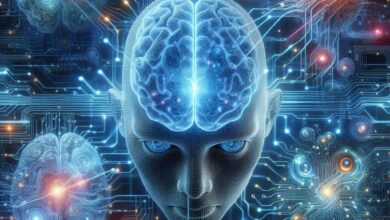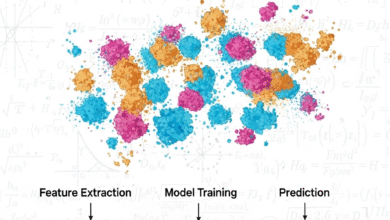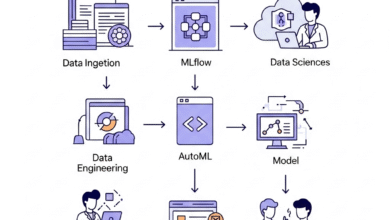
Mastering AI with Azure Machine Learning : A Smart Toolbox for the Future
Hello, Tech Friends! Have you ever imagined creating advanced AI models without the hassle of setting up servers, installing libraries here and there, or worrying about managing computational scale? Or maybe you want to truly focus on your ideas and data, leaving the infrastructure and deployment to someone else? Well, it’s time for you to get acquainted with Azure Machine Learning (Azure ML) – Microsoft’s all-in-one cloud platform that makes the process of creating, training, and deploying machine learning models as easy as diving into a clear swimming pool!
Imagine Azure Machine Learning as a smart toolbox and expert assistant for your ML journey. From collecting and cleaning data, training models using powerful GPUs, to deploying models as APIs or applications that can be used by thousands of people in real-time – all can be done in one integrated environment. You don’t need to be a DevOps expert to start experimenting with AI!
What is Azure Machine Learning? More Than Just a Place to Train Models!
In essence, Azure Machine Learning is a cloud service that provides everything you need to manage the machine learning lifecycle end-to-end. It’s not just a place to turn on machines to train models, but a complete ecosystem that includes:
-
Workspace: Your “virtual office” in Azure. This is the central place for all your ML activities: projects, data, computation, models, experiments, deployment, all organized neatly here. Secure and manageable access.
-
Compute Resources: This is the muscle! Azure ML provides a variety of options:
- Compute Instances: Ready-to-use virtual machines (VMs) that come pre-installed with all popular ML tools (Python, R, TensorFlow, PyTorch, scikit-learn, etc.). Suitable for development, small experiments, or Jupyter notebooks.
- Compute Clusters: A collection of VMs that can auto-scale (automatically add or reduce nodes) based on workload. Great for training large models that take a long time.
- Inference Clusters: Dedicated clusters for serving deployed models, handling prediction requests (inference) in real-time.
- Attached Compute: You can connect other computing resources in Azure, like Azure Databricks or Kubernetes clusters, directly to your Azure ML workspace.
- GPU Power: Full support for GPUs (NVIDIA) which are crucial for speeding up the training of complex deep learning models.
-
Datastores & Datasets: A secure place to store and manage your data.
- Datastores: Connections to data storage locations in Azure (Azure Blob Storage, Azure Data Lake Gen1/Gen2, Azure SQL DB, etc.) or even on-premises (with certain conditions). Azure ML does not store the original data but links to the storage you specify.
- Datasets: Objects in Azure ML that represent your data. They facilitate access and manipulation of data (dataset versions can be tracked!), and are important for consistent and reproducible training.
-
Automated Machine Learning (AutoML): A flagship feature for those who want to quickly get good models without having to be hyperparameter tuning experts! Just provide the data, specify the target (e.g., classification or regression), and AutoML will automatically:
- Try dozens of different ML algorithms (from simple ones like Linear Regression to complex ones like LightGBM, XGBoost, or Deep Learning).
- Tweak the hyperparameters of each algorithm to find the best combination.
- Evaluate the performance of each model and show which model is the most accurate (or according to other metrics you choose). Saves time and allows you to focus on interpreting results!
-
Azure Machine Learning Designer: A drag-and-drop feature that makes creating ML pipelines as easy as playing with puzzles! Perfect for beginners or for quick prototyping. You can pull modules (data reading, preprocessing, training, evaluation, deployment) and connect them into a visual workflow without writing any code at all (or using custom code if needed). Very intuitive!
-
Notebooks: An integrated Jupyter Notebook environment directly in the workspace. Complete with popular libraries, suitable for data exploration, coding models using Python/R, and documenting your steps. Accessible via browser.
-
Experiment Tracking & Model Management: Very important for reproducibility and collaboration!
- Experiments: Every time you run training (whether through code, AutoML, or Designer), Azure ML tracks it as an “Experiment.” It stores logs, metrics (accuracy, loss, etc.), outputs, and even the versions of code and data used. So, you can compare results from different runs and know exactly what changed.
- Model Registry: A central repository for storing your validated trained models. You can version models, add tags or descriptions, and track which models have been deployed to production.
-
MLOps (Machine Learning Operations): This is the strategy to make your ML process solid, automated, and production-ready!
- Pipelines: Create automated ML workflows that can be triggered by new data or scheduled routines. For example: A pipeline can take the latest data, clean it, train a new model, evaluate it, and if it’s good, automatically register the new model or even deploy it to replace the old model.
- Model Deployment: Deploy models as web services (REST APIs) that can be accessed by other applications, or as modules in Azure IoT Edge for inference on edge devices (close to the data source). Azure ML handles the infrastructure, scaling, and monitoring.
- Monitoring: Monitor model performance in production (latency, throughput, resource usage), detect data drift (changes in input data distribution that can make the model inaccurate), and model drift (decline in model performance over time).
- Integration with Azure DevOps/GitHub Actions: Automate CI/CD (Continuous Integration/Continuous Deployment) specifically for ML pipelines, ensuring smooth and tested model updates to production.
Why Choose Azure Machine Learning? Advantages That Will Make You a Fan
-
End-to-End Platform: From data to deployment to monitoring, everything in one place. No need to integrate dozens of different tools that can be confusing.
-
User -Friendly: Options for how to work: like coding? Notebooks and SDKs (Python/R) are ready. Prefer visual? Designer and AutoML are the solutions. Suitable for all skill levels.
-
Scalability & Powerful Computing: Need to train a deep learning model using 100 GPUs? Or handle millions of inference requests per second? Azure ML can scale as needed, paying according to usage (pay-as-you-go). No need for expensive server investments.
-
Tight Integration with the Azure Ecosystem: Seamlessly connects to Azure Data Factory (ETL/ELT), Azure Synapse Analytics (data warehouse/data lakehouse), Azure Databricks (big data analytics), Azure IoT Hub (IoT data), Azure Kubernetes Service (AKS) for advanced deployment, Power BI for visualization, and much more. The full power of Azure cloud is utilized.
-
Enterprise-Class Security and Compliance: Built on secure Azure infrastructure, supporting industry compliance standards (such as HIPAA, GDPR, FedRAMP), role-based access control (RBAC), and data encryption. Very important for enterprises.
-
Strong MLOps: Not just creating models, but also ensuring that models can be operationalized effectively, managed, and continuously monitored in production environments. This is key to the long-term success of ML projects.
-
Large Community and Support: As part of Microsoft Azure, the support documentation, tutorials, community forums, and technical support services are extensive.
Azure ML in Action: Real Examples Bringing Solutions
Not just theory, Azure ML has been used across various industries to solve real problems:
-
Retail & E-commerce:
- Recommendation Systems: Personalizing products for each customer (AutoML, Collaborative Filtering).
- Demand Forecasting: Optimizing stock & logistics (Time Series Forecasting).
- Fraud Detection: Detecting suspicious transactions in real-time (Anomaly Detection).
-
Healthcare & Pharmaceuticals:
- Medical Image Analysis: Helping detect anomalies in X-Rays, MRIs, CT Scans (CNN via Designer or Notebook).
- Drug Discovery: Predicting molecular interactions (Complex Deep Learning Models).
- Patient Risk Prediction: Identifying high-risk patients (Classification Models).
-
Manufacturing:
- Predictive Maintenance: Predicting when machines will fail, minimizing downtime (Time Series, Sensor Data).
- Automated Quality Control: Detecting product defects on the assembly line (Computer Vision).
-
Finance & Banking:
- Credit Scoring: More accurate creditworthiness analysis (AutoML Classification).
- Anti-Money Laundering (AML): Identifying suspicious transaction patterns (Anomaly Detection).
- Customer Service Chatbots: Automating responses to common inquiries (NLP, Deployment as Web Service).
-
IoT & Smart City:
- Sensor Data Analysis: Predicting traffic congestion, optimizing energy consumption (Time Series on Inference Edge).
- Infrastructure Inspection: Detecting road/bridge damage from drones (Computer Vision).
How to Get Started Quickly with Azure Machine Learning
Not sure where to start? Don’t worry, the steps are simple:
-
Create an Azure Account: Have a Microsoft account? Just sign up for Azure (there’s a free tier for initial exploration!).
-
Create an Azure Machine Learning Workspace: Search for “Machine Learning” at portal.azure.com, follow the guide to create a new workspace (choose a name, resource group, nearest region).
-
Explore the Studio: Open studio.azureml.net, log in, and select your workspace. This is your main dashboard!
-
Choose Your Working Method:
- AutoML: In the left menu, select “Automated ML” > “New automated ML job.” Follow the wizard: select the dataset, specify the target column, choose the type of task (classification/regression/forecasting), select the compute target (e.g., compute cluster), and run it!
- Designer: Select “Designer” > “Create pipeline.” Drag modules from the left panel, connect them, configure, and submit the pipeline to the compute target.
- Notebooks: Select “Notebooks.” Create a new notebook or upload an existing one. Access the compute instance directly from here to run code. Use the Azure ML SDK (azureml-core, azureml-train, etc.) to control all Azure ML features via Python/R.
- SDK: Install the Azure ML SDK (pip install azureml-sdk[notebooks,automl]) in your local Python/R environment or on the compute instance. Start coding to manage data, training, experiments, and deployment.
-
Successfully Deploy the Model: Once you have a model registered in the Model Registry, select “Endpoints” > create a new deployment (choose the model, compute target for inference like AKS or Managed Endpoint, specify scaling). Get the REST API endpoint URL!
-
Monitor & Manage: Monitor endpoint performance, detect drift, and automatically retrain the model if necessary through MLOps features.
Cost Considerations: Efficiency is Key
Like other cloud services, Azure ML costs depend on usage (pay-as-you-go). The main cost components include:
- Computation: Costs per hour/second of using compute instances, compute clusters, inference clusters, or AKS. GPUs are more expensive than CPUs. Auto-scaling helps save costs.
- Storage: Costs for storing data in datastores (Azure Blob Storage, etc.) and artifacts (models, logs, snapshots) in workspace storage.
- Managed Endpoints: Costs per hour for the infrastructure plus costs per request (inference request).
- Premium Features: Some advanced MLOps features or data labeling may incur additional costs.
Cost-Saving Tips:
- Turn off compute instances when not in use (can be scheduled for auto-shutdown).
- Choose the appropriate VM size (don’t overprovision).
- Use low-priority VMs for training that can tolerate interruptions (cheaper).
- Delete compute clusters when not active.
- Monitor resource usage through Azure Cost Management.
The Future of Azure Machine Learning: Continuing to Evolve with Smarter and More Responsible AI
Microsoft continues to make significant investments in Azure ML. Future trends include:
-
Integrated Responsible AI: Tools for bias detection, fairness assessment, and explainability (model interpretation) will be increasingly integrated into the Azure ML workflow, helping practitioners build fairer and more trustworthy AI.
-
Generative AI & Large Language Models (LLMs): Easier integration with advanced generative models like GPT-4 or open-source models (e.g., via Hugging Face on Azure) for applications like creative content, advanced chatbots, and code generation. Prompt flow features for managing LLM workflows.
-
More “Auto” AutoML: AutoML will become smarter, potentially tackling more complex or multi-modal tasks (combining text, images, sound), and more automated in data preprocessing.
-
More Automated & Intelligent MLOps: MLOps automation will deepen, with more proactive retraining based on drift detection, smarter alerting, and tighter governance models.
-
Stronger Edge AI: More mature and efficient support for deploying and managing edge models (on Azure IoT Edge) for inference in remote or latency-sensitive locations.
-
Seamless Integration: Closer unification with the entire suite of Azure data and AI services (Purview, Fabric, Cognitive Services) forming a truly integrated analytics and AI platform.
Conclusion: Azure ML, Your Loyal Companion on the AI Journey
Azure Machine Learning is not just a tool, but a strong foundation for building, deploying, and managing machine learning and AI solutions professionally in the cloud era. With a combination of comprehensive features (from AutoML and Designer for beginners to advanced MLOps for experts), high scalability, guaranteed security, and seamless integration with the Azure ecosystem, this platform empowers data scientists, engineers, and developers to innovate faster and create real impact.
Whether you are a beginner wanting to experiment with AI, a practitioner looking to streamline workflows, or a company wanting to scale ML solutions to production, Azure Machine Learning offers the toolkit and infrastructure needed for success. By continuously innovating in line with the latest AI developments, Azure ML positions itself as a leader in making access to and management of machine learning power easier for everyone.
Let’s start your AI adventure in the cloud! Try Azure ML today and experience the ease of building a smarter future. Have you tried it yet? Or do you have exciting AI project plans? Share your experiences or questions in the comments! 😊
FAQ (Frequently Asked Questions) about Azure Machine Learning
Q: What’s the difference between Azure Machine Learning and other cloud ML services (AWS SageMaker, GCP Vertex AI)?
A: Conceptually, they are similar (end-to-end platforms). The main differences lie in:
- Ecosystem Integration: Azure ML is tightly integrated with other Microsoft/Azure products (Power BI, Synapse, Dynamics 365, Office 365) that are very popular in enterprises. This is a significant advantage in corporate environments.
- User Interface (UI): Azure ML Studio is generally considered very intuitive and comprehensive, especially its Designer.
- Microsoft Focus: Responsible AI features and integration with Microsoft developer tools (Visual Studio, GitHub) are often stronger.
The best choice often depends on: which cloud provider the company is already using, team skills, and specific integration needs.
Q: Do I need to be proficient in Python coding to use Azure ML?
A: No! Azure ML is very flexible:
- AutoML & Designer: Can be used without writing any code at all.
- SDK (Python/R): Required if you want full control and custom automation. But there are many code examples and documentation available. Using Notebooks with Python is the most popular way for those comfortable with coding.
Q: Is my data safe in Azure ML?
A: Yes, very safe. Azure ML is built on Azure infrastructure that meets the highest security and compliance standards (ISO, SOC, HIPAA, GDPR, etc.). Data is stored in your Azure storage (Blob, ADLS), not in “Microsoft’s place.” Access is tightly controlled through Azure Active Directory (AAD) and RBAC. Data encryption at rest and in transit is applied.
Q: What is Azure ML Studio vs Azure ML SDK?
A:
- Azure Machine Learning Studio: A web-based interface (web UI) that provides visual access to all features (manage data, AutoML, Designer, Notebooks, experiments, models, endpoints, etc.).
- Azure Machine Learning SDK (Python/R): A set of libraries/commands to control and automate all aspects of Azure ML through code. Suitable for automation, integration into CI/CD, and more granular control. Can be used in Notebooks in Studio or in local coding environments.
Q: Are there certifications for Azure Machine Learning?
A: Yes! Microsoft offers officially recognized certifications, such as:
- Microsoft Certified: Azure Data Scientist Associate: Focused on implementing ML solutions in Azure, including the use of Azure ML. A key certification for Data Scientist roles.
- Microsoft Certified: Azure AI Engineer Associate: Broader to AI solutions, including Cognitive Services, but also covers the use of Azure ML for custom models.
These certifications demonstrate practical expertise and are highly valuable for careers in data/AI.




